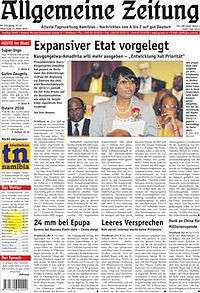Allgemeine Zeitung (Namibia)
The Allgemeine Zeitung (literally in English 'General Newspaper') founded in 1916, is the oldest daily newspaper in Namibia and the only German-language daily in Africa of which survived World War I.[1]
 | |
| Type | daily, Mon-Fr |
|---|---|
| Owner(s) | Democratic Media Holdings Pty Ltd. |
| Managing editors | Stefan Fischer |
| Founded | 1916 |
| Language | German |
| Headquarters | Windhoek, Namibia |
| Circulation | 5000-6000 |
| Website | www.az.com.na |
Profile
The Allgemeine Zeitung is a Namibian newspaper. It is written by 10 editors; most of the staff members are either born or naturalized Namibians. The newspaper leans liberal-conservative.[2]
With a steadily growing circulation from about 5,300 copies (Mondays to Thursdays, 12 to 16 pages) to about 6,200 copies (Fridays, up to 32 pages) (status: November 2015; up from 5,000 and 6,000, respectively, in 2009) the "AZ" is read mostly by German-speaking Namibians (~25,000). A few hundred papers are sent to South Africa and some (mostly the Friday release) to Namibian expatriates and to Germany. Once a month (usually on the first Tuesday of the month), an extra for tourists is added. The circulation then increases to about 12,000 copies.[2]
In 1991 Democratic Media Holdings (DMH) bought the Newspaper. The managing editor since 2004 is Stefan Fischer.[3] He modernized the design, which increased demand and led to initial profit for the Allgemeine Zeitung. DMH also prints and releases Die Republikein, which is written in Afrikaans, and the Namibian Sun. All editorial content in the newspaper is written in German, a common minority language in Namibia which had attempts to revitalize as the official language.[2]
History
The Allgemeine Zeitung was founded on 22 July 1916 under the name Der Kriegsbote (literally 'The War Envoy') and reported on the events of the First World War. After Germany was defeated and lost German South West Africa (now Namibia) to South Africa, the name was changed to Allgemeine Zeitung on 1 July 1919.
In 1937, the newspaper was bought by the publisher John Meinert Ltd. The newspaper was released daily, except for Sundays, with a circulation of 1,800 copies. Most of the readers were Germans from Windhoek and surroundings. At that time the tagline was changed to indicate the intent to "support German national interests". For a short while starting in 1939, the newspaper was released under the name Deutscher Beobachter ('German Observer').
At the same time, smaller newspapers were released, such as Der Farmer ('The Farmer'), Das Volksblatt ('The People's Paper') owned by the Workers Association of South Africa, the Karakulzüchter ('The Karakul Stockman'), founded in 1933, and the Heimat ('Home'), a German paper for Africa's evangelical community.
In 1958, Kurt Dahlmann, Germany's highest-decorated Jabo pilot of World War II,[4] was hired as editor-in-chief. Writing under the pen name Stachus, symbolised as a potted cactus with an oblique dip pen, Dahlmann was adamant about the fleeting nature of apartheid. He wrote many editorials on this topic, suggesting ways that Namibia and South Africa should address the issue of inevitable black rule in both countries.[5]
In 1978, when the AZ and the Windhoek Advertiser were the only independent newspapers in South West Africa, Diether Lauenstein purchased both papers.[6][7] Dahlmann alleged that the money came from the regime in Pretoria;[8] Klaus Dierks states that the German right-wing Hanns Seidel Foundation was the source of the financial backing. Dahlmann was fired and Lauenstein took over the editorship himself with the aim of bringing the paper "on a more conservative, pro-South African, pro-Apartheid and anti-Independence course".[9] In 1981 Hans Feddersen became editor-in-chief.[10]
Literature
- Karl Bömer: Handbuch der Weltpresse: Eine Darstellung des Zeitungswesens aller Länder. Leipzig, Frankfurt am Main: Armanen-Verlag, 1937.
- Regina Reinsperger: Diether Lauenstein und die Apartheid [Diether Lauenstein and Apartheid]. Allgemeine Zeitung via yumpu.com, last accessed on 2 October 2017
See also
- Media of Namibia
References
- Hartman, Adam (December 8, 2008). "Namibia: Namib Times Celebrates 50 Years". AllAfrica Global Media. Retrieved December 16, 2008.
- "AZ-Profil D&E". Allgemeine Zeitung. Retrieved February 5, 2020.
- Der Märkische Bote: „Weiße Geschichten in Druckschwarz“, last view at 1. October 2012.
- "Dahlmann, Kurt". Lexicon der Wehrmacht (in German).
- "20 Jahre lang Stoff für den Glossentopf - Resümee eines Dieners". Allgemeine Zeitung (in German). 4 August 2006.
- Carsten von Nahmen: Deutschsprachige Medien in Namibia - Vom Windhoeker Anzeiger zum deutschen Hörfunkprogramm der Namibian Broadcasting Corporation: Geschichte, Bedeutung und Funktion der deutschsprachigen Medien in Namibia 1898 - 1998. Windhoek: Namibia Wissenschaftliche Gesellschaft, 2001.
- "Seid nett zu den armen Namibia-Deutschen" [Be kind to the poor German Namibians]. Der Spiegel (in German) (35). 28 August 1978.
- "Spitze des Eisbergs" [Tip of the iceberg]. Der Spiegel (in German). 13 November 1978.
- "Biographies of Namibian Personalities: L". Namibia Library of Dr. Klaus Dierks.
- Dierks, Klaus. "Chronology of Namibian History, 1981". klausdierks.com. Retrieved 30 October 2017.